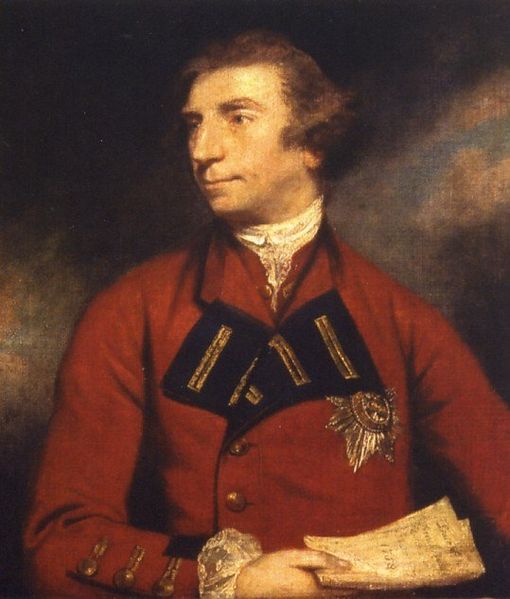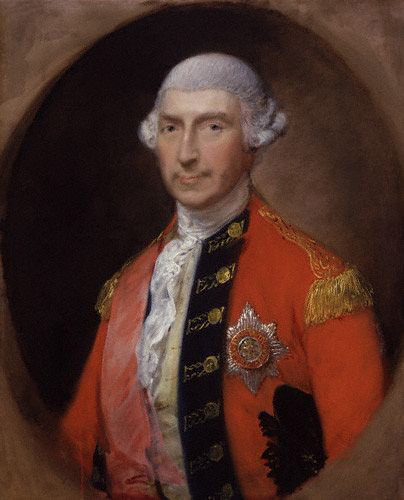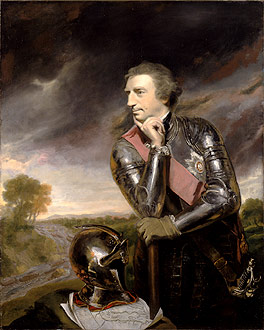<Back to Index>
- Commander - in - Chief of the Forces Field Marshal Jeffery Amherst, 1st Baron Amherst, 1717
PAGE SPONSOR



Field Marshal Jeffery Amherst, 1st Baron Amherst KCB (sometimes spelled Geoffrey, or Jeffrey, he himself spelled his name as Jeffery) (29 January 1717 – 3 August 1797) served as an officer in the British Army and as Commander - in - Chief of the Forces.
Amherst is best known as one of the victors of the French and Indian War, when he conquered Louisbourg, Quebec City and Montreal. He was also the first British Governor General in the territories that eventually became Canada. Numerous places and streets are named for him, both in Canada and the United States.
Born the son of Jeffrey Amherst (d. 1750), a Kentish lawyer, and Elizabeth Amherst (née Kerrill), Jeffery Amherst was born in Sevenoaks, England, on 29 January 1717. His brothers included Admiral John Amherst and Lieutenant General William Amherst. At an early age he became a page to the Duke of Dorset. Amherst became an ensign in the Grenadier Guards in 1735.
He served in the War of the Austrian Succession becoming an aide to General John Ligonier and participating in the Battle of Dettingen in June 1743 and the Battle of Fontenoy in May 1745. Promoted to lieutenant colonel on 25 December 1745, he also saw action at the Battle of Rocoux in October 1746. He then became an aide to the Duke of Cumberland, the commander of the British forces, and saw further action at the Battle of Lauffeld in July 1747.
In February 1756 Amherst was appointed commissar to the Hessian forces that had been assembled to defend Hanover as part of the Army of Observation: as it appeared likely a French invasion attempt against Britain itself was imminent, Amherst was ordered in April to arrange the transportation of thousands of the Germans to southern England to bolster Britain's defenses. He was made colonel of the 15th Regiment of Foot on 12 June 1756. By 1757 as the immediate danger to Britain had passed the troops were moved back to Hanover to join a growing army under the Duke of Cumberland and Amherst fought with the Hessians under Cumberland's command at the Battle of Hastenbeck in July 1757: the Allied defeat there forced the army into a steady retreat northwards to Stade on the North Sea coast.
Amherst was left dispirited by the retreat and by the Convention of Klosterzeven by which Hanover agreed to withdraw from the war: he began to prepare to disband the Hessian troops under his command, only to receive word that the Convention had been repudiated and the Allied force was being reformed.
Amherst gained fame during the Seven Years' War, particularly in the North American campaign known in the United States as the French and Indian War when he led the British attack on Louisbourg on Cape Breton Island in June 1758.
In the wake of this he was appointed commander - in - chief of the British army in North America and colonel - in - chief of the 60th (Royal American) Regiment in September 1758. Amherst then led an army against French troops on Lake Champlain, where he captured Fort Ticonderoga in July 1759, while another army under Sir William Johnson took Niagara also in July 1759 and James Wolfe besieged and eventually captured Quebec with a third army in September 1759. Amherst served as the nominal Crown Governor of Virginia from 12 September 1759.
On 8 September 1760, Amherst led an army down the Saint Lawrence River from Lake Ontario, and captured Montreal, ending French rule in North America. He infuriated the French commanders by refusing them the "honors of war" (the ceremonial right of a defeated garrison to retain their flags); the Knight of Lévis burned the colors rather than surrendering them.
In recognition of this victory, Amherst was appointed Governor General of British North America in September 1760 and promoted to major general on 29 November 1760. He was appointed Knight of the Order of the Bath on 11 April 1761.
From his base at New York, Amherst oversaw the dispatch of troops to take part in British expeditions in the West Indies that led to the British capturing Dominica in 1761 and Martinique and Cuba in 1762.
The hostility between the British and Native Americans after the French and Indian War led to one of the first documented attempts at biological warfare in North American history. In response to the 1763 uprising known as Pontiac's Rebellion, the Commander of Fort Pitt proposed giving blankets infected with smallpox to American Indians. Amherst approved the plan and expressed his willingness to adopt any "other method that can serve to Extirpate this Execrable Race."
Amherst was summoned home, ostensibly so he could be consulted on future military plans in North America, and expected to be praised for his conquest of Canada but instead, once in London, was asked to account for the recent rebellion. He was forced to defend his conduct, and faced complaints made by Sir William Johnson and George Croghan who successfully lobbied the Board of Trade leading to Amherst's removal. Nevertheless he was promoted to lieutenant general on 26 March 1765 and became colonel of the 3rd Regiment of Foot in November 1768.
On 22 October 1772 Amherst was appointed Lieutenant General of the Ordnance and soon gained the confidence of George III who had initially hoped the position would go to a member of the Royal Family. On 6 November 1772 he became a member of the Privy Council.
Amherst was raised to the peerage on 14 May 1776, as Baron Amherst of Holmesdale. On 24 March 1778 he was promoted to full general and, in April 1778, he became Commander - in - Chief of the Forces, which gave him a seat in the Cabinet.
In 1778 when the British commander in North America, William Howe, requested to be relieved, Amherst was considered as a replacement by the government: however, his insistence that it would require 75,000 troops to fully defeat the rebellion was not acceptable to the government, and Henry Clinton was instead chosen to take over from Howe in America. Following the British setback at Saratoga, Amherst successfully argued for a limited war in North America, keeping footholds along the coast, defending Canada, East and West Florida, and the West Indies while putting more effort into the war at sea. On 7 November 1778 the King and Queen visited Amherst at his home, Montreal Park, in Kent, and on 24 April 1779 he became colonel of the 2nd Troop of Horse Grenadier Guards.
A long standing plan of the French had been the concept of an invasion of Great Britain which they hoped would lead to a swift end to the war if it was successful: in 1779 Spain entered the war on the side of France, and the increasingly depleted state of British home forces made an invasion more appealing and Amherst organized Britain's land defenses in anticipation of the invasion which never materialized.
In June 1780 Amherst oversaw the British army as they suppressed the anti - Catholic Gordon Riots in London: after the outbreak of rioting Amherst deployed the small London garrison of Horse and Foot Guards as best as he could but was hindered by the reluctance of the civil magistrates to authorize decisive action against the rioters. Line troops and militia were brought in from surrounding counties, swelling the forces at Amherst's disposal to over 15,000 many of whom were quartered in tents in Hyde Park and a form of Martial Law was declared, giving the troops the authority to fire on crowds if the Riot Act had first been read; although order was eventually restored, Amherst was personally alarmed by the failure of the authorities to suppress the riots. In the wake of the Gordon Riots, Amherst was forced to resign as Commander - in - Chief in February 1782 and was replaced by Henry Conway. On 23 March 1782 he became captain and colonel of the 2nd Troop of Horse Guards.
On 8 July 1788 he became colonel of the 2nd Regiment of Life Guards and on 30 August 1788 he was created Baron Amherst of Montreal with a special provision that would allow this title to pass to his nephew (as Amherst was childless, the Holmesdale title became extinct upon his death). With the advent of the French Revolutionary Wars, Amherst was recalled as Commander - in - Chief of the Forces in January 1793: however is generally criticized for allowing the armed forces to slide into acute decline, a direct cause of the failure of the early campaigns in the Low Countries: William Pitt said of him "his age, and perhaps his natural temper, are little suited to the activity and the energy which the present moment calls for". Horace Walpole called him "that log of wood whose stupidity and incapacity are past belief". "He allowed innumerable abuses to grow up in the army… He kept his command, though almost in his dotage, with a tenacity that cannot be too much censured". He retired from that post in February 1795, to be replaced by the Duke of York, and was promoted to the rank of Field Marshal on 2 August 1796. He retired to his home at Montreal Park and died on 3 August 1797.
In 1753 he married Jane Dalison; following the death of his first wife he married Elizabeth Cary in 1767. There were no children by either marriage.
Several places are named for him: Amherstburg, Ontario (location of General Amherst High School), Amherst, Massachusetts (location of the University of Massachusetts - Amherst and Amherst College), Amherst, New Hampshire, Amherst, Nova Scotia, Amherst, New York, and Amherst County, Virginia.
"The Un-Canadians", an 2007 article in Beaver Magazine, includes
Jeffery Amherst, 1st Baron Amherst, Ezekiel Stone Wiggins and Robert
Monckton
in a list of people in the history of Canada who were considered
contemptible: "British North America Governor General Jeffrey Amherst
supported plans of distributing smallpox infested blankets to First
Nations people."